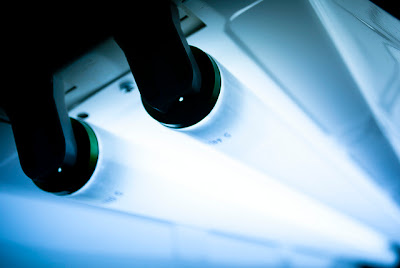Just as the name suggests, continuous light sources are the ones that emits light continuously. Unlike flash units or strobes that emit light in a pulse or flash continuous light sources stay on all the time. They enable you to visualize the scene more clearly. You also could use a simple ambient light meter to take your readings no need of fancy flash meter. Being a WYSIWYG (what you see is what you get) interface, continuous light sources are more preferred by amateurs or others starting out in photography.
Continuous light sources could be broadly classified into three categories namely;
Continuous light sources could be broadly classified into three categories namely;
- Tungsten Lights
- Metal Discharge Lights and
- Fluorescent Light Panels.
Tungsten Lights
Tungsten lights are the oldest form of lighting devices. It is also sometimes referred to as ‘ARRI’ as a result of their long history producing tungsten lights. Tungsten lights have been in the industry from the beginnings of the photography and thus have evolved quite a number of varieties of spots and floods and also accessories and light modifiers; more than any other light source. Barn doors, snoots, grids, beauty dishes, etc. are all available for tungsten lights. Tungsten lights are the cheapest to acquire but as they are not energy efficient they have high running costs.
 |
| Photo By Zcreem |
Tungsten lights are available in powers ranging from 500 watts to 2000 watts and are rated by their wattage. Tungsten lights typically have a yellow tint to them so in order to render true colours when using tungsten lighting either attach an 80B filter to the lens or attach blue gels to the light source. Digital cameras tungsten white balance should provide acceptable colours though not accurate because as tungsten bulbs age their colour temperature varies.
Tungsten bulbs are not the energy efficient, eco friendly kind of lighting equipment, they convert electric energy into light and heat. As a result equipments heat up also heating the studio, lights and modifiers get very hot that handling them and also attaching modifiers like gels becomes a bit tricky. Also there is loss of energy making it sometimes hard to get enough light to produce sufficient depth of filed required by the image. More on Tungsten Lights
Metal discharge lights use bulbs with mercury in them; producing light cooler than tungsten lamps. Their output ratio is also much higher than that of tungsten, giving much more power for the same wattage. Metal discharge lights are balanced for daylight colour temperature, high intensity discharge (HID) lights (including HMI and HQI) fall under this category. They find most application in the movie industry and is growing in popularity among still life photographers and also photographers who shoot interiors as they are flicker free when compared to fluorescent lamps.
Tungsten bulbs are not the energy efficient, eco friendly kind of lighting equipment, they convert electric energy into light and heat. As a result equipments heat up also heating the studio, lights and modifiers get very hot that handling them and also attaching modifiers like gels becomes a bit tricky. Also there is loss of energy making it sometimes hard to get enough light to produce sufficient depth of filed required by the image. More on Tungsten Lights
Metal Discharge Lights
Metal discharge lights use bulbs with mercury in them; producing light cooler than tungsten lamps. Their output ratio is also much higher than that of tungsten, giving much more power for the same wattage. Metal discharge lights are balanced for daylight colour temperature, high intensity discharge (HID) lights (including HMI and HQI) fall under this category. They find most application in the movie industry and is growing in popularity among still life photographers and also photographers who shoot interiors as they are flicker free when compared to fluorescent lamps.
 |
| HMI Lights |
Fluorescent Light Panels
Fluorescent light panels have tubes arranged together in groups to produce soft, diffused light with little shadows. Studio fluorescent lights are daylight balanced and have been in use in the television studios for many years.
 |
| Photo By XCutt |
Although daylight balanced they give a slight green tint to images and also their power output is very limited making them unsuitable for most serious work. – More on Fluorescent Lights